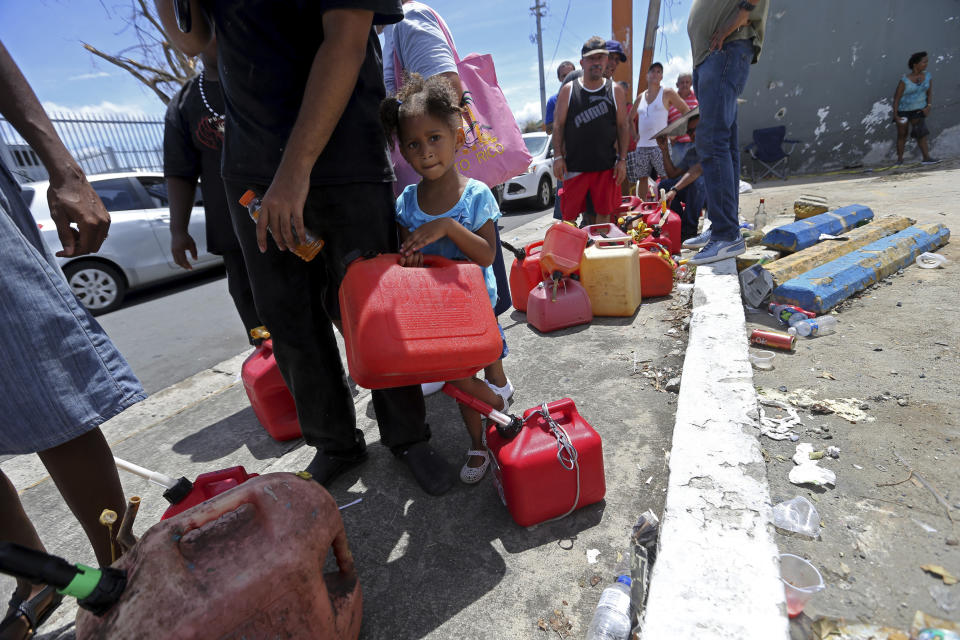Powerless Puerto Ricans huddle around their generators

BAYAMON, Puerto Rico — By 6 p.m., Calle Alameda is completely dark except for a few houses, where the sing-song of Puerto Rico’s coqui frogs is drowned out by the loud humming of a generator.
On an island that was already suffering from a crippling economic crisis, 20 days after Hurricane Maria knocked out Puerto Rico’s electrical grid, possession of a diesel-run generator is the surest way to separate the haves from the have-nots.
“We were very lucky,” said Adolfus Trevi?o, a longtime resident of Calle Alameda, a residential street in suburban Bayamon. Trevi?o bought his 2.8-kilowatt generator from Costco before Hurricane Irma, because Puerto Rico’s vulnerable electrical grid had already been making locals susceptible to semi-regular power outages, and because this one was on sale for $600.
As Maria made its way toward the island last month, 12 of Trevi?o’s relatives took shelter in his house, including two of his adult daughters and a 96-year-old aunt. Everyone took turns waiting in line for gasoline to make sure there would be enough for the generator.
“Thank God we did not run out,” he said.

Slideshow: Puerto Rico after Hurricane Maria >>>
Now, thanks to their generator, which can run for 8 or 9 hours on about a gallon and a half of gasoline, Trevi?o told Yahoo News, “I’ve been able to use my fridge, five fans, give electricity to the lady across the street for her fridge, and to the neighbor beside me here for a couple of fans for them.”
“We feel blessed with the 2.8-kilowatt generator,” Trevi?o said, noting that once Maria hit, home generators like his became scarce. That wattage is small for a home generator; most models for sale on the mainland are at least twice that capacity, ranging up to more than 20 kilowatts — but those consume much more fuel.
“You can’t buy them right now, actually,” he said. “And if you were able to, like Home Depot has [re-stocked] some, 5 to 6 kilowatts, where they use five gallons, even six gallons every eight or nine hours, which is ridiculous.”
To protect against potential theft, Trevi?o has his generator chained to the ground behind his house.
In more rural areas, some people are rumored to be reselling their own generators at a surcharge.
“It’s basically cheaper to buy a flight, get a generator and bring it down here,” said Jesse Vazquez, who travelled to Bayamon from New York with his sister, Megan, this week to bring a generator to their father and 89-year-old grandmother. They were among many Puerto Rican-Americans checking brand new generators along with their luggage at New York’s Kennedy Airport.

Their father, a retired veteran also named Jesse Vazquez, said he scouted out the same generator as his neighbor, Trevi?o, but even the $600 sale price was too steep for his budget.
“I was aware of the potential for this kind of situation, not only [the hurricane] but the power goes out here sometimes,” he said. “But I just couldn’t afford it. I’m on a fixed income, Social Security.”
Ninety percent of Puerto Rico still lacks electricity 20 days after Maria tore through the island. The residents of Bayamon are among the roughly half who were without running water as of last Friday; the situation isn’t thought to have changed much since then.
Beyond the residential streets like Calle Alameda, much larger generators are being used to power big-box stores like Walmart and Costco, where long lines of Bayamon residents wait for hours in the thick, 90 degree heat, to buy food, bottled water and other supplies. But even those machines can only do so much. Inside the nearby Amigo, a local supermarket chain owned by Walmart, it is immediately clear from the smell of rotting vegetables that the large generator outside is only being used to power the lights and a few fans.

The sound of generator motors, not unlike lawnmowers, can be heard throughout the capital of San Juan as well.
The generators are a welcome, if limited, reprieve for families like the Vazquez’s, who, over the past few weeks, have been forced to find alternative ways to navigate the oppressive heat and darkness, like using the elder Jesse’s car battery to power electric fans and recharge cell phones. Still, they are hardly a long-term solution.
With gas prices around $2.66 a gallon, it will cost the Vazquez’s about $18.60 a week to fuel their generator for about 5 hours each day — close to $80 a month.
“It’s more expensive than my light bill,” said Trevi?o of his own generator, which is even more energy efficient. “My light bill is normally $75 a month.”
In addition to the costs, the generators can be dangerous. Refilling them with gasoline can cause fires or worse. The generators must be kept outside and at least 20 feet from windows to prevent carbon monoxide poisoning. Weather adds yet another element to this puzzle as rain begins to fall from the pitch black sky over Alameda Street.

“Don’t put it on the porch, someone will take it,” the elder Vazquez tells his son, as the two try to figure out where put the generator so that it won’t get wet or stolen, or blow toxic chemicals into their house or those nearby.
Not everyone is as considerate. The exhaust fumes from the next-door neighbor’s generator waft into Vazquez’s living room as his daughter, Megan, readies for bed.
“Tomorrow, we have to go get a carbon monoxide detector,” she says.
_____
Read more from Yahoo News:


